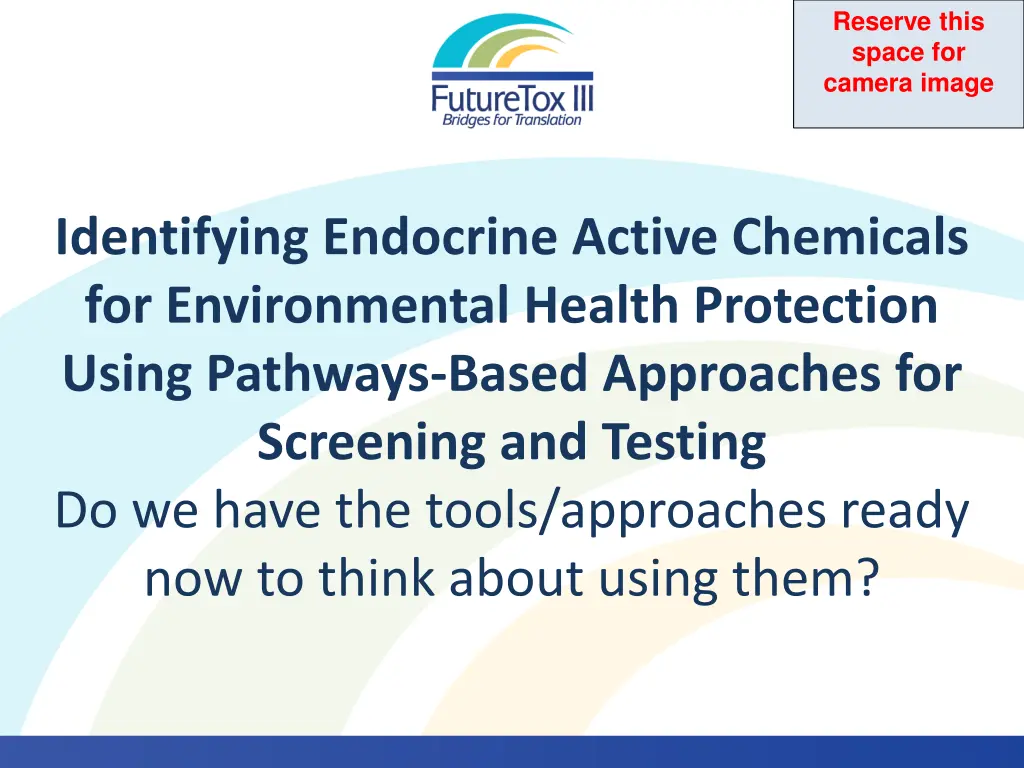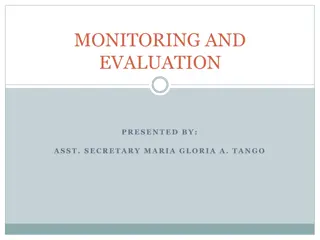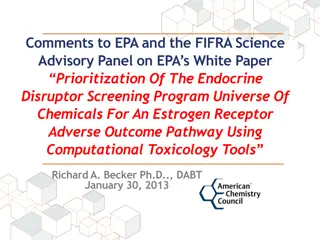
Identifying Endocrine Active Chemicals Using Pathways-Based Approaches
"Explore the tools and approaches available for identifying endocrine active chemicals, including pathways such as estrogen, androgen, thyroid, and more. Discover how CompTox and predictive models are utilized for screening, and the importance of adequately characterizing pathways for hazard assessment and regulatory purposes."
Download Presentation

Please find below an Image/Link to download the presentation.
The content on the website is provided AS IS for your information and personal use only. It may not be sold, licensed, or shared on other websites without obtaining consent from the author. If you encounter any issues during the download, it is possible that the publisher has removed the file from their server.
You are allowed to download the files provided on this website for personal or commercial use, subject to the condition that they are used lawfully. All files are the property of their respective owners.
The content on the website is provided AS IS for your information and personal use only. It may not be sold, licensed, or shared on other websites without obtaining consent from the author.
E N D
Presentation Transcript
Reserve this space for camera image Identifying Endocrine Active Chemicals for Environmental Health Protection Using Pathways-Based Approaches for Screening and Testing Do we have the tools/approaches ready now to think about using them?
Reserve this space for camera image Which pathways define the endocrine system? To meet regulatory requirements Estrogen, Androgen, Thyroid = EDSP For protecting human health For protecting the environment
Reserve this space for camera image US using CompTox and predictive models for screening Additional predictive models under development for EAT Addition endocrine pathways are important Progesterone Adrenal steroids PPAR Insulin Non-receptor mediated effects (e.g. metabolism) Other factors beyond pathway based interactions (e.g. environmental fate, degradation)
Reserve this space for camera image Which pathways are adequately characterized for hazard assessment and/or regulatory purposes? Estrogen: EPA has tools to provide alternative data to ER (and link to hazard) Non-receptor mediated effects are not captured What is needed to link non-receptor mediated effects to pathway (i.e. hazard id) MoA or Qualitative AOP needed for hazard identification Route of exposure Linkage between bioactivity and hazard (or everything is a potential endocrine disruptor) E.g. is there anything feasible linking ER pathway (mechanism) leading to reproductive failure probably yes; probably not so for PXR May want to consider potency/what are cutoffs May be some uncertainty in mechanisms (e.g. Sulfotransferase depletion of estrogen) or pathway interaction Concept of casting a wider net Possibility of using AOP framework to build those associations
Reserve this space for camera image Androgen receptor Similar story to ER Do we have tools available to build alternative to existing Tier 1 (AR binding, Hershberger) Need relevant reference chemicals with range of potencies HB may pick up effects other than AR (e.g. metabolism)
Reserve this space for camera image Metabolism Tests (or models) to identify chemicals that are metabolically activated Critical to measure chemicals that induce altered steroid homeostasis When that homeostasis is specific to endocrine system Homeostatic in vitro assays where chemicals can be identified that alter homeostasis
Reserve this space for camera image Reference Chemicals Coverage of non-HTS amenable chemical space and new chemistries (e.g. Nano) Modeling fate and transport with respect to humans and environment/eco Casting a wider net to capture broad endocrine effects vs. pathway-specific assay batteries Measurement of internal doses and use of small model organisms
Reserve this space for camera image Global Acceptance Fit for purpose and performance based validation Harmonized recommendations for testing strategies that would be widely accepted by regulators Hazard vs Risk based assessments
Reserve this space for camera image Data Sharing Failed products/compounds Retrospective and prospective Industry sponsored formulation testing


